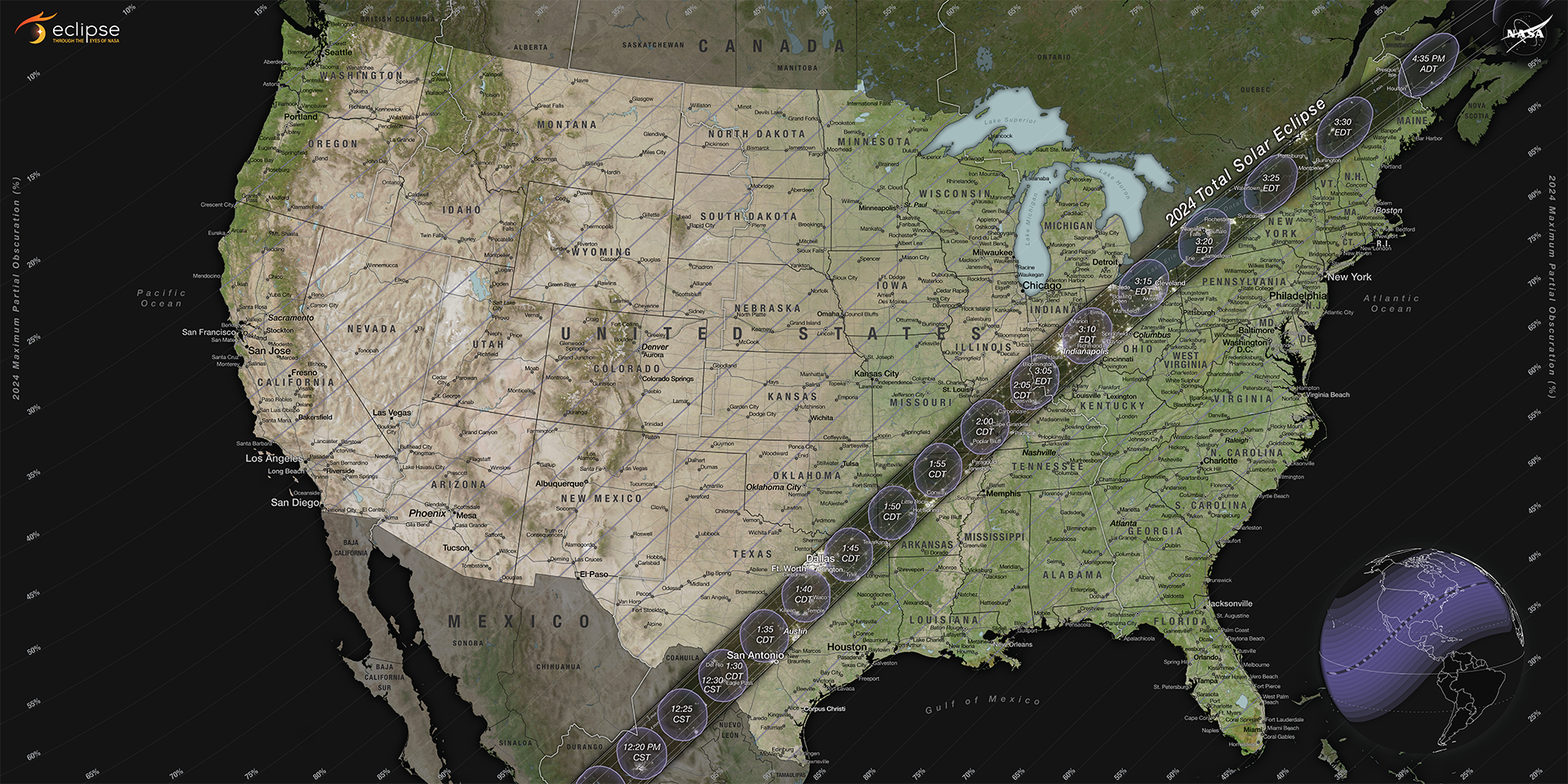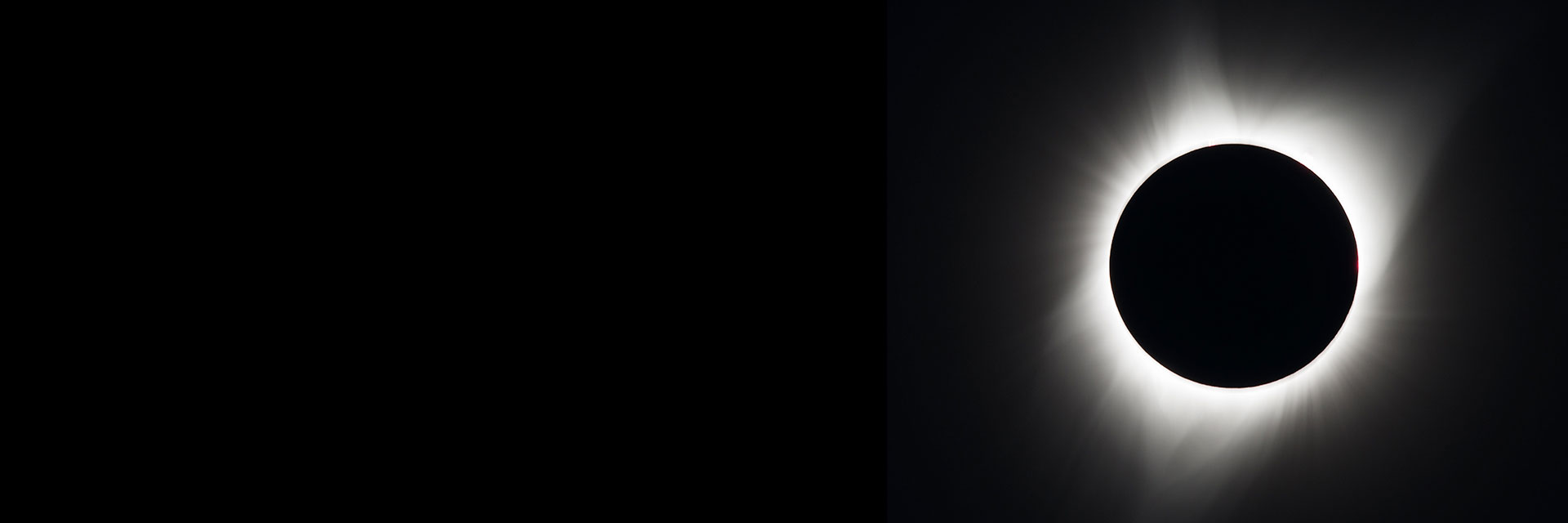The eclipse on Monday, April 8, 2024, was a total solar eclipse. It was the last total solar eclipse visible from the contiguous United States until 2044.
A total solar eclipse happens when the Moon passes between the Sun and Earth, completely blocking the face of the Sun. People viewing the eclipse from locations where the Moon’s shadow completely covers the Sun – known as the path of totality – will experience a total solar eclipse. The sky will become dark, as if it were dawn or dusk. Weather permitting, people along the path of totality will see the Sun’s corona, or outer atmosphere, which is usually obscured by the bright face of the Sun.

What to Expect When You're Expecting a Total Solar Eclipse
Get ready for the big day with our in-depth guide on planning for and experiencing a total solar eclipse.
Read the Guide
A total solar eclipse is the only type of solar eclipse where viewers can momentarily remove their eclipse glasses (which are not the same as regular sunglasses). It is only safe to remove your eclipse glasses during what’s known as totality, the brief period of time when the Moon is completely blocking the Sun.
What you can see during a total solar eclipse depends on the weather and the location from which you view it.
Weather: You need clear skies to have the full eclipse experience, with a clear view of the Sun and Moon. However, the eerie daytime darkness associated with eclipses is still noticeable with cloud cover.
Location: To see all stages of a total solar eclipse, you must view it from somewhere along the path of totality: the locations on Earth from which the Moon’s shadow completely covers the Sun. The path of totality for the April 8, 2024, total solar eclipse is shown below in gray. Observers viewing the eclipse from outside the path of totality may observe a partial eclipse, where the Moon covers most but not all of the Sun. Eclipse glasses are required for the entire duration of the eclipse when viewing from outside the path of totality.

Stages of a Total Solar Eclipse
There are several distinct stages of a total solar eclipse that observers can watch for. You must not remove your eclipse glasses until the Moon has completely covered the Sun, the portion of the eclipse known as “totality.”
Partial Eclipse

As the Moon passes between the Sun and Earth, at first it does not completely cover the Sun. The Sun appears to have a crescent shape. For most locations, the partial eclipse phase will last between 70 and 80 minutes. You must wear your eclipse glasses when viewing the Sun during the partial eclipse phase. The moment when the Moon first "touches" the Sun is also called the first contact.
Shadow Bands
Shadow bands are rapidly moving, long, dark bands separated by white spaces that can be seen on the sides of buildings or the ground just before and after totality, though they can be very faint and difficult to photograph. Earth’s upper atmosphere contains turbulent cells of air that distort the sharp-edged light from the solar surface, the same way it distorts starlight and causes stars to twinkle.
Baily’s Beads

As the Moon continues to move across the Sun, several points of light shine around the Moon’s edges. Known as Baily's Beads, these are light rays from the Sun streaming through the valleys along the Moon's horizon. Baily’s Beads are very short-lived, and may not last long enough to be noticeable to all observers of the total solar eclipse.
Diamond Ring

Baily’s Beads will begin to disappear until eventually only a single bright spot will remain along the edge of the Moon’s shadow. This bright spot resembles the diamond in a giant diamond ring formed by the rest of the Sun’s atmosphere. Totality is almost here – but keep those eclipse glasses on!
Totality

Once the diamond ring disappears and there is no longer any direct sunlight, you may remove your eclipse glasses and look at the total eclipse safely with the naked eye. This moment is also called second contact. During totality, viewers may be able to see the chromosphere (a region of the solar atmosphere, appearing as the thin circle of pink around the Moon) and the corona (the outer solar atmosphere, appearing as streams of white light). Be vigilant to protect your eyes and put your eclipse glasses back on before totality ends. Totality may last only a minute or two in some locations.
During totality, take a few seconds to observe the world around you. You may be able to see a 360-degree sunset. You may also be able to see some particularly bright stars or planets in the darkened sky. The air temperature will drop and often an eerie silence will settle around you. It is also worth stealing a peek at the people around you – many people have a deep emotional response when the Sun goes into totality.
Brightening Reappears
As the Moon continues to move across the face of the Sun, you will begin to see brightening on the opposite side from where the diamond ring shone at the beginning. This is the lower atmosphere of the Sun, beginning to peek out from behind the Moon and it is your signal to stop looking directly at the eclipse. Make sure your eclipse glasses are back on – or you are otherwise watching the eclipse through a safe, indirect method – before the first flash of sunlight appears around the edges of the Moon. This moment is also called third contact.
Diamond Ring, Baily’s Beads, and Shadow Bands – Again
Once your eyes are protected again, you may continue to watch the final stages of the eclipse as the end process mirrors the beginning: You will again see the diamond ring, Baily’s Beads, and shadow bands before the entire Sun is visible.
Fourth contact is the moment that none of the Sun is covered by the Moon’s shadow. This is when the eclipse is completely over, but most likely you will have already packed up your things and began planning your next eclipse adventure.





